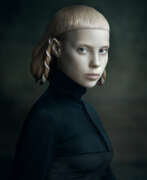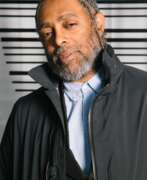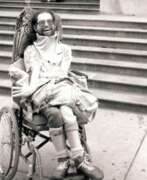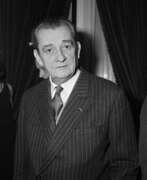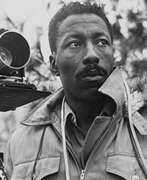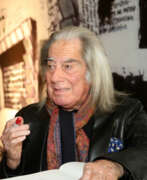Filmmakers 20th century


Herbert Ritts Jr. was an American fashion photographer and director known for his photographs of celebrities, models, and other cultural figures throughout the 1980s and 1990s. His work concentrated on black and white photography and portraits, often in the style of classical Greek sculpture, which emphasized the human shape.




Marina Abramović is a Serbian conceptual and performance artist. Her work explores body art, endurance art, feminist art, the relationship between the performer and audience, the limits of the body, and the possibilities of the mind. Being active for over four decades, Abramović refers to herself as the "grandmother of performance art". She pioneered a new notion of identity by bringing in the participation of observers, focusing on "confronting pain, blood, and physical limits of the body". In 2007, she founded the Marina Abramović Institute (MAI), a non-profit foundation for performance art.


Marc Adrian is an Austrian conceptual artist and filmmaker.
Adrian studied sculpture at the Vienna Academy of Fine Arts, from 1953 he became interested in cinema, kinetics, rhythmic interference, problems of optical structures, etc. Adrian is considered one of the pioneers of film-oriented media art. He specialized in kinetic objects, anti-cinema and computer art.
Marc Adrian has taught at various universities in Europe and lectured to American students.




Christian Ludwig Attersee, born Christian Ludwig, is an Austrian media artist living in Vienna and Semmering in Lower Austria.
The artist took his middle name, Attersee, from the area where he spent his youth. He studied at the Vienna Academy of Applied Arts and his work was characterized early on by flamboyant sexualization. He is known not only as a visual artist, but also as a musician, writer, object artist, designer, stage designer and film director. In the 1960s and 1970s he also created series on themes of food, everyday objects, beauty and cosmetics.
Attersee is known above all as one of the leading representatives of objective painting in Europe in the last 50 years. In the second half of the seventies he became the founder of the "New Austrian Painting". From 1990 to 2009, Atterse held a chair at the Vienna University of Applied Arts.


Margit Balla is a Hungarian artist, graphic artist, illustrator, director, stage designer and costume designer.
She studied typography at the Academy of Applied Arts in Budapest, mainly making posters, book illustrations, later working more and more with pictorial graphics. In her posters Margit Balla combines impressions from old prints with contemporary trends such as pop art. Her figurative compositions are easily recognizable by her special surrealistic drawing style.
Since 2000, Margit Balla has been working as a production designer for the Budapest Puppet Theater.


Thomas Baumann is an Austrian artist and filmmaker living and working in Vienna.
Baumann studied at the Academy of Fine Arts in Vienna, but is engaged in a wide range of creative endeavors. He mixes categories of art and challenges values and forms. Through his electronic sculptures, machine paintings, films and installations that give visitors their own freedom of action, Baumann searches for structural connections between material and mental spaces.
For example, one of his spatial sculptures with a pre-programmed score: silver foil moves in a certain rhythm, it straightens, contracts or expands. The sculpture is constantly changing its form - it destroys the shape it has just taken to create a new one. Baumann also constructs artworks from floor ropes, swings, doors, organ pipes and other objects. Many of his works contain acoustic elements. Since 1990, Bauman has also made films and videos.


Miguel Rio Branco, full name Miguel da Silva Paranhos do Rio Branco, is a Brazilian photographer, artist, director and creator of multimedia installations.
His father was a diplomat and as a child Miguel lived in Spain, Portugal, Switzerland and the USA, now living and working in Rio de Janeiro, Brazil. After earning a degree in photography from the New York Institute of Photography, Miguel first worked as a cameraman and then worked with the Magnum agency. Miguel is known for exploring and crossing two different art forms: painting and photography. He has also shot 14 short films and eight long films, he is recognized in the world as one of the best color photojournalists.
Miguel Rio Branco's photographs are part of the collections of the Museum of Modern Art and the Metropolitan Museum of Art in New York.
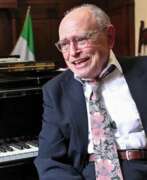

Silvano Bussotti is an Italian composer, painter and opera director, set and costume designer.
Silvano learned to play the violin at an early age, studied harmony and counterpoint at the Cherubini Conservatory in Florence, and studied with various teachers. In addition to music, he was fond of drawing and painting. His first works, influenced by Luigi Dallapiccola and Roberto Lupi, were written in the avant-garde dodecaphonic technique, and he also made extensive use of the aleatoric method. Bussotti was a participant in "anti-music" concerts, for which he created works without any sounds at all.
Bussotti's compositions include numerous pieces for various vocal, instrumental and mixed ensembles. In 1963 he co-founded the Group of 70 (Florence). Between 1968 and 2001 he worked as a director, costume designer and stage designer at the leading opera houses in Italy, La Scala, La Fenice; Massimo (Palermo), Reggio (Turin) and others. In total, he created about 40 opera productions.
Bussotti's art exhibitions are held in various countries around the world. Bussotti is also known for his extravagant graphic scores, in which he found self-expression as an artist, but this hides the meaningful nature of his musical achievements.
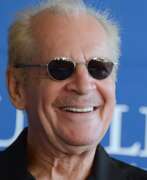

Larry Clark is an American film director, photographer, writer and film producer who is best known for his controversial teen film Kids (1995) and his photography book Tulsa (1971). His work focuses primarily on youth who casually engage in illegal drug use, underage sex, and violence, and who are part of a specific subculture, such as surfing, punk rock, or skateboarding.


Jean Maurice Eugène Clément Cocteau was a French poet, playwright, novelist, designer, filmmaker, visual artist and critic. He was one of the foremost creatives of the surrealist, avant-garde, and Dadaist movements; and one of the most influential figures in early 20th-century art as a whole. The National Observer suggested that, “of the artistic generation whose daring gave birth to Twentieth Century Art, Cocteau came closest to being a Renaissance man.”


Anton Corbijn is a renowned Dutch photographer, film director, and music video director, born on May 20, 1955, in Strijen, the Netherlands. His career took off photographing musicians like Herman Brood, eventually leading to international acclaim. Known for his long-standing collaborations with bands Depeche Mode and U2, Corbijn has creatively directed their visual outputs for over three decades.
Corbijn's artistic prowess extends to directing critically acclaimed films such as "Control" about Joy Division's Ian Curtis, which garnered multiple awards, including the Michael Powell award for best new British feature at the Edinburgh International Film Festival. His other directorial works include "The American" and "A Most Wanted Man". In photography, his portraits span icons like Jimmy Page, Robert Plant, and Bob Dylan, with his pieces often gracing album covers for many influential music acts.
Collectors and experts recognize Corbijn for his distinctive style that captures the essence of his subjects, making his work highly sought after in the art and music worlds. His notable works are displayed in museums and form an integral part of music history, as seen in his album covers for Metallica, Nick Cave, and others.


Noël Peirce Coward was an English playwright, composer, director, actor, and singer, known for his wit, flamboyance, and what Time magazine called «a sense of personal style, a combination of cheek and chic, pose and poise».


Salvador Dalí, a Spanish Surrealist painter and printmaker, is celebrated for his vivid and imaginative works that delve into subconscious imagery. Born on May 11, 1904, in Figueres, Catalonia, Spain, Dalí's early exposure to Impressionism and Renaissance masters significantly influenced his artistic development. His education in fine arts in Madrid further shaped his style, leading him to experiment with Cubism and avant-garde movements. In the late 1920s, Dalí embraced Surrealism, joining the Surrealist group in 1929 and rapidly becoming one of its most prominent figures.
Dalí's most famous work, "The Persistence of Memory," completed in 1931, epitomizes the Surrealist movement with its iconic melting clocks symbolizing the fluidity of time. His artistic repertoire was diverse, including painting, graphic arts, film, sculpture, design, and photography, often incorporating themes of dreams, the subconscious, sexuality, religion, and science. Despite his remarkable artistic contributions, Dalí's eccentric and flamboyant public persona often overshadowed his work. He faced criticism for his public support of the Francoist regime and the authenticity of some of his late works.
Dalí's legacy is preserved in major museums, notably the Dalí Theatre-Museum in Figueres and the Salvador Dalí Museum in St. Petersburg, Florida. These institutions showcase his extensive and varied body of work, illustrating his profound impact on Surrealism, pop art, and contemporary artists.
If you're captivated by the surreal world of Salvador Dalí and want to stay informed about new sales and auction events featuring his works, sign up for our updates. Our service is tailored specifically for art collectors and experts, providing timely information and insights into the vibrant market of Dalí's art. Remember, this subscription is focused solely on bringing you the latest in product sales and auction events related to Salvador Dalí. Don't miss out on the opportunity to enrich your collection with pieces from one of the most influential surrealists of all time. Sign up now and be the first to know about these exclusive events.


Charles Eames and Ray Eames were an American couple of industrial designers who made significant historical contributions to the development of modern architecture and furniture through the work of the Eames Office.
Charles and Ray Eames also worked in industrial and graphic design, fine art and film. Charles was the public face of Eames Office, but Ray and Charles worked together as creative partners and engaged a diverse creative staff. Some of their best known designs include the Eames Lounge Chair and the Eames Dining Chair.
The Charles and Rae Eames design firm has existed for over four decades.


Alfred Ehrhardt was a universally talented German artist. He was an organist and choirmaster, then a music and art teacher in a remedial school, and finally an art teacher and painter, before becoming a photographer and director.
After spending the winter semester 1928-29 at the Bauhaus Dessau, where he was decisively influenced by Josef Albers, Wassily Kandinsky, Paul Klee and Oskar Schlemmer, he transferred the Bauhaus pre-course concept to his art lessons with children and young people, beginning in first grade and continuing through Abitur. Based on this experimental experience, in 1930 he was appointed to the Landeskunstschule Hamburg, where he created the first preliminary course in materials science outside the Bauhaus. After being dismissed by the National Socialists from the university in 1933 because of his modernist views of art, he turned to photography and film.
Alfred Ehrhardt is considered an outstanding representative of the new objective photography. After publishing more than 20 photobooks, he became one of the most successful photographers among the former Bauhaus artists. His "absolutely artistic films", which defy modernity and are inspired by the avant-garde of the 1920s, place him among the old masters of cultural and documentary cinema. Alfred Erhardt is considered "Germany's most important post-war creator of cultural films" and has received numerous national and international awards for his more than 50 films, including four Federal Film Prizes.
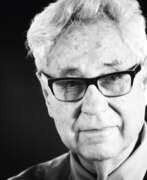

Elliott Erwitt is a French-born American advertising and documentary photographer known for his black and white candid photos of ironic and absurd situations within everyday settings. He has been a member of Magnum Photos since 1953.




Robert Frank was a Swiss photographer and documentary filmmaker, who became an American binational. His most notable work, the 1958 book titled The Americans, earned Frank comparisons to a modern-day de Tocqueville for his fresh and nuanced outsider's view of American society. Critic Sean O'Hagan, writing in The Guardian in 2014, said The Americans "changed the nature of photography, what it could say and how it could say it. it remains perhaps the most influential photography book of the 20th century." Frank later expanded into film and video and experimented with manipulating photographs and photomontage.


Gunther Gerzso was a Mexican painter, designer and director and screenwriter for film and theatre.
Gunther Gerzso was awarded the Guggenheim Fellowship in 1973 and later in 1978 he was the recipient of the Premio Nacional de Bellas Artes.


Francis Giacobetti is a French photographer and filmmaker.
In 1984 he began a series of celebrity photographs that included Federico Fellini, Stephen Hawking, Françoise Sagan, Philippe Starck, Yehudi Menuhin and others, over 200 in all. Known for being on the border between photography and painting, between craft and art, Francis Giacobetti has puzzled and delighted art masters with his series (Zebras, Iris, Anthem, numerous Bacon portraits). Like many photographers, he celebrates the beauty and perfection of the human body.
Giacobetti is also the director of the film Emmanuelle l'Antivierge (1975).
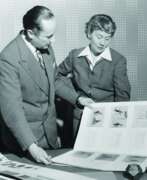

Halas and Batchelor Animation, Ltd. is a British animation company founded in 1940 that became the largest animation studio in Great Britain. It operated until 1986.
The company was founded by John Halas (April 16, 1912 - January 21, 1995) and Joy Batchelor (May 12, 1914 - May 14, 1991). The company's productions were designed for the international level, and war information and propaganda films were made here. Halas and Batchelor's most famous work is the 1954 film Animal Farm, an animated version of George Orwell's novel Animal Farm. It was England's first full-length color cartoon and was funded by the CIA as part of the American anti-communist campaign during the Cold War.
Many later cartoons, documentaries and educational shorts were commissioned from the studio specifically for television. In 1972 Halas became an Officer of the Order of the British Empire.


Dennis Lee Hopper was not only a prominent figure in the American film industry but also an accomplished photographer whose work captured the essence of a transformative era in the United States. Hopper's artistic journey spanned various mediums, with photography holding a special place in his array of talents. His photographic career, which began in earnest during the 1960s, offers a compelling glimpse into the cultural and social landscapes of the time.
Dennis Lee Hopper's photography is celebrated for its raw, candid portrayal of his surroundings, capturing moments that range from the intimate to the chaotic. His images provide a personal narrative of his life and times, reflecting his connections with key cultural and artistic figures of the era. His work is not just a collection of images but a visual diary, chronicling the vibrant and often tumultuous world he inhabited.
Notably, Dennis Lee Hopper's photographic portfolio offers an invaluable perspective on the American counterculture movement, showcasing his keen eye for composition and his ability to capture the spirit of the moment. His photographs, including portraits of famous contemporaries and snapshots of street scenes, resonate with authenticity and artistic integrity.
For collectors and enthusiasts in the realms of art and antiques, Dennis Lee Hopper's photographs represent a unique convergence of cinematic and photographic artistry. His works not only capture moments in time but also evoke the broader cultural shifts of his era. For those interested in exploring Hopper's photographic legacy, staying informed about exhibitions and auctions can provide opportunities to engage with his work more deeply and appreciate his contribution to the art of photography.
To stay updated on Dennis Lee Hopper's photographic works and related events, subscribing to updates from art galleries and auction houses is recommended. This subscription will provide timely information on new exhibitions, sales, and insights into Hopper's impact on the world of photography and art.


Rebecca Horn is a German visual artist, who is best known for her installation art, film directing, and her body modifications such as Einhorn (Unicorn), a body-suit with a very large horn projecting vertically from the headpiece. She directed the films Der Eintänzer (1978), La ferdinanda: Sonate für eine Medici-Villa (1982) and Buster's Bedroom (1990). Horn presently lives and works in Paris and Berlin.


Pieter Hugo is a South African portrait and documentary photographer recognized for capturing the marginalized peoples of the continent. He lives and works in Cape Town.
Hugo is a self-taught photographer, primarily because there was nowhere to get an education in photography theory and history in Cape Town. After graduating from high school, he immediately became a practicing photographer. He subsequently participated in many exhibitions and published four monographs.




William Klein was an American-born French photographer and filmmaker noted for his ironic approach to both media and his extensive use of unusual photographic techniques in the context of photojournalism and fashion photography. He was ranked 25th on Professional Photographer's list of 100 most influential photographers.
Klein trained as a painter, studying under Fernand Léger, and found early success with exhibitions of his work. He soon moved on to photography and achieved widespread fame as a fashion photographer for Vogue and for his photo essays on various cities. He directed feature-length fiction films, numerous short and feature-length documentaries and produced over 250 television commercials.


Eva Kot'átková is a Czech installation artist and filmmaker living and working in Prague.
Eva studied at the Prague Academy of Fine Arts, the Prague Academy of Applied Arts, the San Francisco Art Institute and the Vienna Academy of Art. The artist's work combines sculpture, text and performance. Her installations usually consist of multiple objects, drawings, photographs, models, and sometimes videos. Her aim is to show how much our personal lives are influenced by our social environment. In her ongoing series "Theater of Talking Objects", Eva Kot'átková tries to find alternative ways of self-expression for those who cannot communicate and integrate in a standard way.
She is co-founder of the Anxiety Institute platform, which examines anxiety as a result of social, political, economic and environmental forces.


David LaChapelle is an American photographer, music video director and film director. He is best known for his work in fashion, photography, which often references art history and sometimes conveys social messages. His photographic style has been described as "hyper-real and slyly subversive" and as "kitsch pop surrealism". Once called the Fellini of photography, LaChapelle has worked for international publications and has had his work exhibited in commercial galleries and institutions around the world.


Robert Longo is an American artist, filmmaker, photographer and musician.
Longo became first well known in the 1980s for his Men in the Cities drawing and print series, which depict sharply dressed men and women writhing in contorted emotion. He lives in New York and East Hampton.


Danny Lyon is an American photographer and filmmaker.
All of Lyon's publications work in the style of photographic New Journalism, meaning that the photographer has become immersed in with, and is a participant of, the documented subject. He is the founding member of the publishing group Bleak Beauty.
After being accepted as the photographer for Student Nonviolent Coordinating Committee (SNCC), Lyon was present at almost all of the major historical events during the Civil Rights Movement.


Steve Rodney McQueen is a British film director, film producer, screenwriter, and video artist. He won the Academy Award for Best Picture at the 2014 Academy Awards for his work on 12 Years a Slave. He studied at Chelsea College of Art and Design, Goldsmiths College in London and Tisch School in New York. In 1999, he received a grant from the Berlin Artist Program of the German Academic Exchange Service (DAAD). In 1999 he received the Turner Prize for his photography and installations. His first films are experimental, minimalist, black-and-white and silent films (Buster Keaton). In 2003, the British Imperial War Museum named McQueen the official war artist of the Iraq War. Following his time in Iraq in 2006, the Queen and Country Project was created, featuring portraits of fallen British soldiers on a sheet of stamps.


Bahman Mohassess was an Iranian painter, sculptor, translator, and theatre director. His oeuvre comprises paintings, sculptures and collages. Known as "the irreverent" artist, Mohasses is said to have destroyed many of his own works, and those that become available at auction are now highly sought after. Mohassess is the most prominent artist who was openly gay in Iran, which is still stigmatized. He was the subject of the Mitra Farahani film documentary, Fifi Howls from Happiness (2013).


Thierry Guetta, better known as Mr Brainwash, is a French-born American street artist and filmmaker known for his unique and unconventional approach to art.
Thierry Guetta is recognised for his collaborations with renowned street artist Banksy. His works combine elements of pop art, street art and graffiti, resulting in colourful and visually impressive works. Getty's work often features cultural icons, famous personalities and popular images, creating a distinctive and recognisable style. With his playful and thought-provoking works, Mr Brainwash continues to push the boundaries of contemporary art and challenge traditional notions of artistic expression.


James (Jamie) Nares is a British transgender woman artist living and working in New York City since 1974. Nares makes paintings and films (most notably the no wave film Rome 78); played guitar in the no wave groups James Chance and the Contortions and the Del-Byzanteens (the latter also including Jim Jarmusch); and was a founding member of Colab.


Hélio Oiticica was a Brazilian visual artist, sculptor, painter, performance artist, and theorist, best known for his participation in the Neo-Concrete Movement, for his innovative use of color, and for what he later termed "environmental art", which included Parangolés and Penetrables, like the famous Tropicália. Oiticica was also a filmmaker and writer.


Jacques Olivar is a Moroccan fashion and advertising photographer and filmmaker.
In his youth he worked as a pilot of passenger air transport, but by the age of 40 he finally realized that photography is his vocation. And he became successful quite quickly. Since 1987, fashion photography has become his main profession. Jacques Olivar works for leading fashion magazines and has won many awards.
Emotion, elegance and beauty are the invariable key elements underlying Jacques Olivar's photographic works. The black and white images create an atmosphere of neorealism, while the color images seem to reference the heyday of cinema and build on the idea of the "American Dream".


Edward Quinn is an Irish photographer famous for his portraits of celebrities and artists.
Edward Quinn began his career as a photojournalist, covering events such as the Spanish Civil War and the Second World War. In the 1950s he moved to the French Riviera and began photographing the rich and famous — Pablo Picasso, Brigitte Bardot, Grace Kelly, Max Ernst, Alexander Calder, Francis Bacon, Salvador Dali, Graham Sutherland, David Hockney.
Quinn's photographs are noted for their naturalness and spontaneity. He had a talent for capturing his subjects in inconspicuous moments and revealing their true essence. His portraits often show his subjects relaxed and at ease, as if they were unaware of the camera's presence.
In addition to photography, Quinn was also a writer and filmmaker. He wrote several books about the French Riviera and made a documentary about Pablo Picasso.
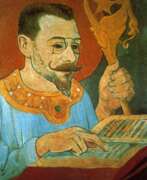

Paul-Élie Ranson, a French painter and writer, emerged as a prominent figure in the late 19th century art scene. Born in Limoges, he was raised by his grandparents and father after his mother's demise during childbirth. Ranson's early artistic inclinations were nurtured with drawing lessons from his grandfather. His educational journey in the arts began at the École des Beaux-Arts Appliqués à l'Industrie and later continued at the Académie Julian in Paris.
Ranson was a pivotal member of "Les Nabis," a group instrumental in transitioning from Impressionism to modern art. Along with notable contemporaries like Paul Sérusier, Pierre Bonnard, and Maurice Denis, he helped establish an art movement that blended elements of Symbolism, Art Nouveau, and Japanese prints. Ranson's role extended beyond painting; he was actively involved in the Symbolist performances at the Théâtre d'Art and directed a notable performance of "Ubu Roi" by Alfred Jarry.
Ranson's artistic oeuvre is marked by a fascination with Theosophy, magic, and occultism, themes that increasingly influenced his work. His paintings often delved into mythology, witchcraft, and anti-clerical subjects. Some of his notable works include "Christ and Buddha" (1880), "Witches Around the Fire" (1891), and "The Blue Room" (circa 1900). These works exemplify his unique blend of thematic and stylistic elements, setting him apart from his contemporaries.
Tragically, Ranson's life was cut short by typhoid fever in 1909. However, his legacy continued through the Académie Ranson, founded by his friends in Les Nabis. This institution, managed initially by Ranson and later by his wife Marie, remained active until 1955, perpetuating his influence on future generations of artists.
For art collectors and experts, Ranson's work offers a unique window into the transitionary period of late 19th-century art, showcasing the interplay of traditional and emerging styles. His contributions to the Symbolist and Nabi movements are particularly noteworthy.
To stay updated on new product sales and auction events related to Paul-Élie Ranson, sign up for our updates. This subscription service is tailored to keep art aficionados informed about the latest developments and opportunities related to Ranson's art.


Man Ray, born Emmanuel Radnitzky, was an American visual artist who played a significant role in the Dada and Surrealist movements. His pioneering efforts in photography, alongside his work in painting and sculpture, have cemented his place as a major figure in modern art. Known for his innovative techniques and the ability to convey complex ideas through simple, striking visuals, Man Ray's contribution to the art world is profound.
Throughout his career, Man Ray was celebrated for his avant-garde approach and his ability to transcend traditional boundaries between different artistic mediums. His photography, characterized by experimental techniques such as solarization and rayographs (cameraless photographs), challenged conventional perceptions of photography as merely a means of representation. These artistic innovations made him a central figure in both Parisian and American art circles.
Man Ray's works are housed in some of the world's most prestigious museums and galleries, including the Museum of Modern Art in New York and the Centre Pompidou in Paris. His pieces, such as "Le Violon d'Ingres" and "Noire et Blanche," are iconic images that continue to influence artists today. His ability to blend the abstract with the realistic, and the humorous with the serious, has left a lasting legacy in the world of art.
For collectors and experts in art and antiques, the work of Man Ray offers a glimpse into the revolutionary changes that shaped the visual arts in the 20th century. His unique perspective and pioneering techniques continue to inspire and challenge those interested in the boundaries of creativity and expression.
If you're passionate about the avant-garde, or simply wish to explore the fascinating world of Man Ray further, sign up for our updates. You'll receive alerts on new product sales and auction events related to Man Ray, ensuring you never miss an opportunity to engage with the legacy of this extraordinary artist.


JR (French: Jean René) is the pseudonym of a French photographer and artist who does not give his full name. He lives and works in Paris and New York.
He describes himself as a "photograffeur" (photographer and graffiti artist in one word) and claims that the street is "the biggest gallery in the world". His work is flyposting large black and white images in public spaces. JR works at the intersection of photography, street art, filmmaking and social activism. Over the past two decades he has developed many public projects in cities around the world, from buildings in the slums of Paris to walls in the Middle East and Africa or favelas in Brazil.
JR places large-scale photographic images in public spaces. He started creating graffiti as a teenager on the streets and rooftops of Paris and on the subway. In 2007, he gained worldwide attention by placing huge photographs of Israelis and Palestinians face to face in eight Palestinian and Israeli cities on both sides of the separation barrier. In his works, the photographer always addresses current political and social issues in the world. For example, in 2019, JR worked with a group of inmates of a maximum security prison in California and created a large format piece with portraits of the inmates.
JR has traveled to many cities with his work, participating in exhibitions, he has collaborated with magazines and created films about his work. JR has also directed three feature-length documentaries, one of which, Women Are Heroes (2011) was nominated for an Oscar. At the 2017 Cannes Film Festival, he won the Golden Eye for Best Documentary.


Johannes Siegfried Richter (German: Johannes Siegfried Richter) or Hans Richter was a German painter, graphic artist, avant-garde film director and film theorist.
Hans Richter studied at the Berlin Academy of Fine Arts, then at the Weimar Academy. He was close to the expressionist group Sturm, influenced by cubism. He had his first solo exhibition in Munich in 1916. From 1916 to 1918, he was a member of the "Dada" group in Zurich. In 1922, came to Berlin. Made several films, where he tried to convey rhythm and movement by abstract means. In 1933 the Nazis ransacked Richter's studio in Berlin, confiscating or destroying his work. He was stripped of his German citizenship and called a "degenerate" artist and a "cultural Bolshevik". In 1940 he moved to the United States. Taught film in New York, continued his film experiments.


Helene Bertha Amalie "Leni" Riefenstahl was a German film director, photographer and actress known for her role in producing Nazi propaganda.
A talented swimmer and an artist, Riefenstahl also became interested in dancing during her childhood, taking lessons and performing across Europe. After seeing a promotional poster for the 1924 film Mountain of Destiny, she was inspired to move into acting and between 1925 and 1929 starred in five successful motion pictures. Riefenstahl became one of the few women in Germany to direct a film during the Weimar Period when, in 1932, she decided to try directing with her own film, Das Blaue Licht ("The Blue Light").


Larry Rivers (born Yitzroch Loiza Grossberg) was an American artist, musician, filmmaker, and occasional actor. Considered by many scholars to be the "Godfather" and "Grandfather" of Pop art, he was one of the first artists to merge non-objective, non-narrative art with narrative and objective abstraction.
































